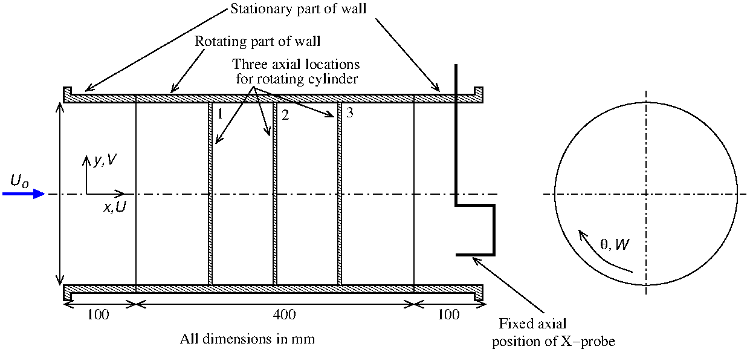Table of Contents
Wake of a Streamwise Axially Rotating Cylinder
Experiments by Wood, Peterson and Clausen
Description
Measurements are given in the turbulent wake of a circular cylinder mounted with its axis normal to the free-stream velocity, and rotating about an axis parallel to the streamwise direction, as shown in figure 1. All three mean velocities and six Reynolds stresses were obtained at three positions downstream of the cylinder.
Two ratios of the circumferential velocity of the cylinder to the free-stream velocity (the swirl number) are considered: 0.3 and 0.57.
Measurements for the two combinations of the free-stream and angular velocity showed the velocity deficit in the wake to be a multi-valued function of the swirl number, implying that the rotation affected the separation of the cylinder's boundary layer in a complex manner. In the turbulent wake, the rotation did not significantly alter the magnitudes of the normal stresses, but caused large changes to the shape of the profiles of the axial and cross-stream normal stresses.
Experimental Details
The experimental apparatus shown in figure 1 had its upstream end fitted to the outlet of a conventional blower wind tunnel. The co-ordinate system shown in the figure rotates relative to fixed “laboratory” co-ordinates which are taken to be inertial.
Broadly the same apparatus was used by Clausen et al (1993) and Mehta et al (1991), but with the addition of a honeycomb section at the upstream end of the rotating part, in order to generate a swirling flow. In the present case, without the honeycomb, the rotating outer part of the outer wall served mainly to rotate the cylinder, and the incoming airflow in the central region (where measurements were taken) was largely unaffected by it.
All the present results were obtained from an X-probe traversed at a fixed axial location, with the circular cylinder at one of the three indicated positions. The cylinder diameter, \(d\), was 5 mm, and the measurements spanned the range \(39 < x/d < 79\).
The rotation or swirl number used to measure the significance of the rotation is defined as \(S = \Omega r/U_o\), where \(U_o\) is the average axial velocity. \(S\) is the inverse of the Rossby number. \(U_o\) was determined at each radius by averaging \(U\) over those regions where \(u'\) was less than 1% of \(U\), which resulted in some small, but not very significant, changes in \(U_o\) with \(r\) and \(x\). The quantity \(S^*\), used below and in the datafiles to distinguish the cases, is the values of \(S\) at \(r=0.1\) m. The conditions for the two cases considered are given in the table below.
| \(S^*\) | \(U_o\) [m/s] | \(\Omega\) [rad/s] |
| 0.3 | 19.28 | 57.6 |
| 0.57 | 13.72 | 78.5 |
Measurement Techniques
Every transverse began at \(r = 0.1\)m, continued at \(r = 0.08\), \(0.06\) and \(0.04\) m and was completed by repeating a profile at \(r = 0.1\) m.
All measurements were obtained using DANTEC 55P51 X-probes fitted with 5µm diameter tungsten wires which had an active length of 1mm and copper plated stubs of about 20µm.
Measurements Errors
In the present experiment the greatest transverse contamination occurred at \(r = 0.10\) m where \(W\) approached 10% of \(U\). Nevertheless, the agreement between the four estimates of \(U\) and \(\overline{u^2}\) was always within the reproduceability as described in Wood et al (1994) for all radii, indicating that there was no significant transverse contamination of the results.
Available Measurements
Data available include circumferential profiles of mean velocities and Reynolds stresses (presented as functions of \(r\theta\)), at \(r=0.1\), \(0.08\), \(0.06\) and \(0.04\) m, and \(x=0.194\), \(0.294\) and \(0.394\) m downstream of the cylinder, for both swirl number cases.
Sample plots of selected quantities are available.
The data can be downloaded as compressed archives from the links below, or as individual files.
The file readme.txt gives details of the file naming convention and data available.
References
- Clausen, P.D., Koh, S.G., Wood, D.H. (1993). Measurements of a swirling turbulent boundary layer developing in a conical diffuser. Experimental Thermal and Fluid Science, Vol. 6, pp. 39-48.
- Mehta, R.D., Wood, D.H., Clausen, P.D. (1991). Some effects of swirl on turbulent mixing layer development. Phys. Fluids A, Vol. 3, pp. 2716-2724.
- Wood, D.H., Peterson, P.L., Clausen, P.D. (1994). The turbulent wake of a circular cylinder rotating about the streamwise axis. Experiments in Fluids, Vol. 16, pp. 375-384.
Indexed data:
| case061 (dbcase, free_flow) | |
|---|---|
| case | 061 |
| title | Wake of a streamwise axially rotating cylinder |
| author | Wood, Peterson, Clausen |
| year | 1994 |
| type | EXP |
| flow_tag | axisymmetric, wake, unsteady |
